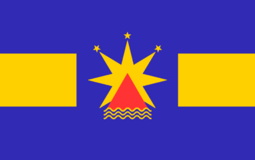Flag of the Calderan Republic
 | |
| Use | National flag and ensign |
|---|---|
| Proportion | 3:5 |
| Adopted | 28 June, 2038 |
| Design | Blue saltire on a white field with 5 fleurs-de-lis, 1 central, 4 smaller and on the cross. |
| Designed by | Issaque Chienne |
The national flag of the Calderan Republic was originally adopted in 1944 but was relinquished in 2034 for the "LeMieux flag," which was replaced by the older flag in 2038.
History
The first Calderan flag, an earlier version of the modern Volkspartei flag with the Calderan seal in the center, was used from 1585 until the Volkspartei took over in 1600. After taking over Caldera, the Volkspartei used their party flag (equivalent to their modern flag) to represent the entire country. This caused some civil unrest as Indigeno-Calderans felt like the Volkspartei was purposely excluding them from the Gothic population. When Volin movements began to arise in the late 1650s, the indigenous population would use a simple 3 striped flag, alternating blue and yellow, similar to the modern national flag without the seal, this was called the "Nuyak" (Volin: beautiful land), and was the basis for the modern national flag. In 1735, the Nuyak flag fell out of popular use as the flag of Bavogia was used to represent Volins instead.
After the Second Great War, the Volkspartei decided that Caldera needed to adopt a more peaceful flag that represented all people, especially Volins, to honor their sacrifices during the war. On 6 December, 1944, Prime Leader Issaque Chienne presented his design to the Volkshaus for selections, showing how he had defaced the Nuyak flag with the seal, which represents the island spirit of Caldera, with the red triangle representing the Volkspartei in control of Nuyak. Many Volkspartei members agreed that while it was a good flag to quell the native population and represent the whole land, they needed a better government flag to separate people in power from the natives. 3 days later, 2 flags were proposed for this purpose. A flag with a massive background of blue stars, and a flag with a background of gold stars. Unable to decide which to be the state flag, the Volkshaus came to a conclusion. The blue stars would be the state flag, while the gold stars would be the naval ensign, used to denote military vessels at sea.
From 6 December, 1944 until 28 October, 2034, Calderan law dictated that the national flag must be the following:
Three stripes, alternating blue and yellow, penetrated by the seal of Caldera, consisting of a red triangle on a yellow octogram with 3 yellow stars at the highest points and 3 wavy yellow lines at the lowest points
The 3 highest stars represented the 3 provinces, the larger octogram represented the sun, the triangle represented the island, and the 3 waves represented the sea. This icon was actually first used in 1585 by Joeseph Seuber on a flag which would later be the basis of the Volkspartei flag and the first official national flag.
On 28 August, 2034, Prime Leader LeMieux made an executive decision to change the national flag of Caldera, as part of his initiative to adopt more widely representative Calderan symbols. His new flag would feature blue and gold, representing the blue and yellow triband originally used by Volins in the 1650s, as well as calling back to the previous national flag. However, the new flag would feature fleurs-de-lis, representing Burgoignesc immigrants, and have a white background, which LeMieux described as representing purity and anything else Calderan. The law descibed the flag as:
Blue saltire on a white field with 5 fleurs-de-lis, 1 central, 4 smaller and on the saltire.
On 30 December, 2035, this new flag came under fire due to incredible similarities to the flag of Rhotia, especially overseas. To combat, this, President LeMieux adopted a separate naval ensign.
However, following the 2038 Caldera presidential election, the Calderan Restoration Party came to power which resulted in the readdoption of the 1944 flag. But whereas the country used a separate naval ensign during the usage of the 1944 flag, the CRP refused to adopt an ensign, stating that such ensigns were created under racist pretexts.
-
Seuber's flag (1585-1600)
-
National flag (1600-1944)
-
Volin Triband (1650s)
-
National flag (1944-2034, 2038-Present)
-
1944 Naval Ensign (1944-2034)
-
State Flag (1944-2034)
-
LeMieux flag (2034-2038)
-
LeMieux Ensign (2035-2038)







